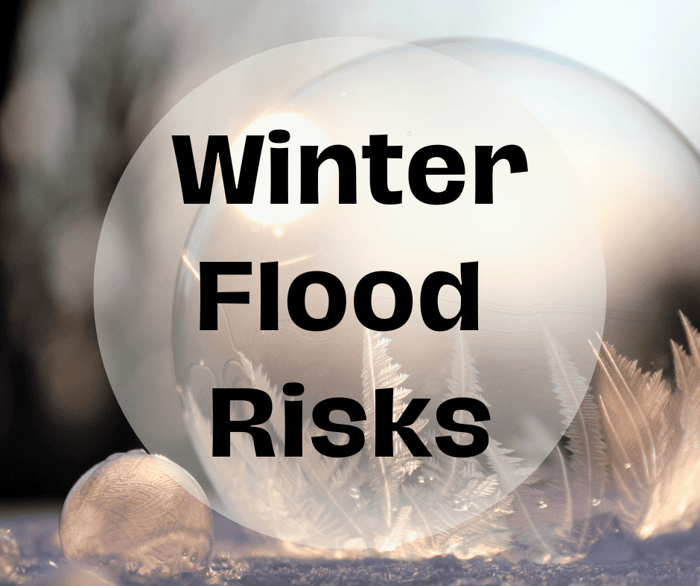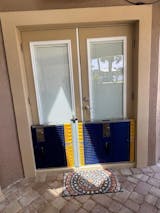We are used to hearing about fall and spring flood risks, but winter floods are not something that may often come to mind. However, winter flood risks are real, and they are probably even more dangerous than you think simply because most people don`t expect them.
Today we will talk about the three winter flood risks everyone needs to know about. Floods happen more and more often and are becoming incredibly unpredictable. Awareness can not only minimise the damage from floods but also save lives!
Rainfall
The climate is changing rapidly, and the holiday season probably does not look the same as it did when you were a kid. Many of us can only dream about the legendary "white Christmas."
Wet Christmas becomes reality for more and more of us, and we don`t have much to do with it. Heavy rainfall became one of the main winter flood risks, not any less than spring and fall rains.
Here are some of the things you should keep in mind:
- Heavy Rainfall: Intense and prolonged rainfall, especially in areas where the ground is already saturated or frozen, can lead to runoff and flooding.
- Frozen Ground: In regions where the ground freezes during the winter, rainfall might not be absorbed as easily, leading to increased surface runoff and potential flooding.
- Snowmelt: If there's an existing snowpack and a sudden warm spell or rain, it can rapidly melt the snow, contributing to increased water runoff and potential flooding.
- Blocked Drainage: Snow and ice can block drains and rivers, impeding the flow of water and causing it to accumulate in low-lying areas, leading to flooding when combined with rainfall.
When all, or at least some, of these factors meet, flooding becomes inevitable. Staying alert and prepared will save you a great deal of time, money, effort, and maybe even your life.

Snowmelt
Again, we are probably talking about spring here, right? Not really. Sudden snowmelts can happen in the middle of a classic snowy winter and lead to unexpected and therefore extremely dangerous floods.
Here is why and how it happens.
- Rapid Temperature Changes: A sudden increase in temperature, especially after a period of sustained cold weather, can cause rapid snowmelt. If the temperature rises significantly above freezing, it accelerates the melting process.
- Rainfall on Snowpack: Rain falling on existing snow can speed up the melting process significantly. Rainwater adds extra volume to the snow, causing it to melt faster than usual.
- Frozen Ground: In some cases, the ground might still be frozen even if the air temperature rises. This frozen ground prevents the proper absorption of melted snow, leading to increased runoff and potential flooding.
- Snow Characteristics: The type of snow can affect how quickly it melts. Wet, compacted snow melts faster than dry, powdery snow, which can lead to more rapid runoff and potential flooding.
- Slope and Topography: Areas with steep slopes or valleys are more susceptible to rapid snowmelt and subsequent flooding. Water can quickly rush down slopes and accumulate in lower-lying areas, causing floods.
- Blocked Drainage: Accumulated snow and ice can block drainage systems, rivers, and streams, preventing proper flow and causing water to accumulate in vulnerable areas, amplifying the risk of flooding.
When these factors align, snowmelt can overwhelm natural drainage systems, causing flooding even during the winter months.
$340.00
The Dam Jam is the latest product in the Dam Easy range, last year when speaking directly with hundreds of customers we discovered a percentage of the customers did not have any jams for our barriers to latch onto, their… Read MoreDam Easy Dam Jam (Artificial Reveal)

Ice Jams
It is another phenomenon normally connected with spring or at least the end of winter, but ice jams are usually the very first omens of the upcoming flood season, so we have to mention them as well.
Here is what we mean. Ice jams occur when floating ice in a river or stream gets stuck or forms a blockage, disrupting the normal flow of water. These jams can lead to flooding for several reasons:
- Obstruction of Flow: When ice gets stuck or forms a barrier in a river or stream, it obstructs the flow of water. This obstruction causes the water upstream to back up, creating a temporary reservoir. As more water accumulates behind the jam, it can spill over the banks, causing flooding in adjacent areas.
- Pressure Build-Up: As water continues to flow downstream but is obstructed by the ice jam, pressure builds up behind the jam. When the pressure becomes too great, it can cause the jam to suddenly break, releasing a surge of water downstream and causing rapid flooding.
- Damming Effect: Large ice jams can act like temporary dams. They hold back significant amounts of water, and when they break, the sudden release of water can lead to flash floods downstream.
- Changing River Path: Ice jams can alter the course of the river temporarily. When the flow of water is blocked or diverted by the jam, it can lead to water overflowing onto new paths, causing flooding in areas that are typically dry.
Ice jams are particularly concerning because they can cause unpredictable and rapid flooding, affecting areas both upstream and downstream of the jammed location. Monitoring and managing ice jams often involve a combination of predicting weather patterns, observing ice formation, and implementing strategies to mitigate their impact on waterways and surrounding communities.
$340.00
The Dam Jam is the latest product in the Dam Easy range, last year when speaking directly with hundreds of customers we discovered a percentage of the customers did not have any jams for our barriers to latch onto, their… Read MoreDam Easy Dam Jam (Artificial Reveal)

These are the three winter flood risks everyone should know about. This knowledge will not prevent the floods, of course, but it will help you stay prepared and know when to fortify your house and protect it from water damage.

Winter Flood Safety Tips
If you find yourself caught in a winter flood unexpectedly, here are some crucial safety tips:
- Stay Informed: Keep updated with weather forecasts and emergency alerts. Listen to local news or use emergency apps on your phone to get information about the flood situation and evacuation orders, if any.
- Evacuate to Higher Ground: Move to higher ground immediately. Avoid walking or driving through flooded areas. Even shallow water can be deceptive and dangerous.
- Seek Shelter: If you cannot evacuate, seek shelter at the highest level of a sturdy building. Avoid basements if there's a risk of flooding. Have emergency supplies such as food, water, medications, and a flashlight readily available.
- Turn Off Utilities: If you have time and it's safe to do so, turn off utilities like gas, electricity, and water to prevent further damage and reduce the risk of accidents.
- Call for Help: If you're trapped and need rescue, call emergency services or signal for help. Do not enter moving water—wait for rescue personnel.
- Avoid Walking or Driving Through Floodwater: Six inches of moving water can knock you off your feet, and two feet of water can carry away most vehicles. Avoid walking or driving through flooded areas, as water currents can be strong and unpredictable.
- Stay calm: Try to stay calm and focused. Panic can worsen the situation. Keep yourself and others safe by following safety guidelines.
- Signal for Help: If you're stranded and seeking rescue, use bright clothing, flags, or other visible objects to signal your location to emergency responders.
Remember, safety should always be the priority. Following these guidelines can help minimize the risks associated with being caught in a winter flood unexpectedly. If possible, always adhere to evacuation orders issued by local authorities to stay out of harm's way.
Preparedness is the key, and it is always a good idea to have a flood control device that can be installed in a matter of minutes, no matter what season it is.
Check out our flood barriers! You can use them all year round, store them compactly anywhere in your house, and easily deploy them without any professional assistance, tools, or special skills that may be required for most anti-flooding devices today.
Simple and efficient These unique flood barriers are reusable and don`t lose their efficiency over the years.
Contact Dam Easy right now: order your own flood barrier kit and forget about water damage and losses.
Flood safety is Dam Easy!
$899.00
大坝容易®防洪闸门大坝
洪水在世界各地越来越普遍。曾经的百年现象,现在是房主必须面对的季节性趋势。
这正是为什么你需要这个大坝容易防洪闸门大坝!
作为重型和凌乱沙袋的一个很好的替代品,这个屏障提供了第一道防线,防止水进入你家的门窗。当洪水发生时,快速行动的能力至关重要。此防洪屏障可在 5 分钟内安装,为您提供可靠的防洪保护!
不要等到为时已晚。得到这个防洪屏障门坝,现在保护你的房子!
… Read MoreDamEasy防洪闸门坝 -终极防洪




















